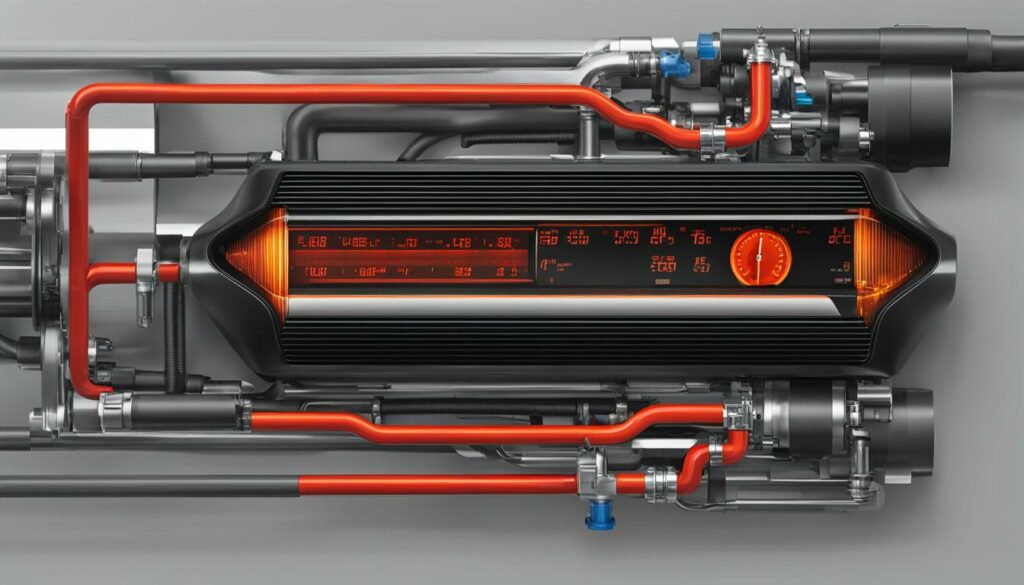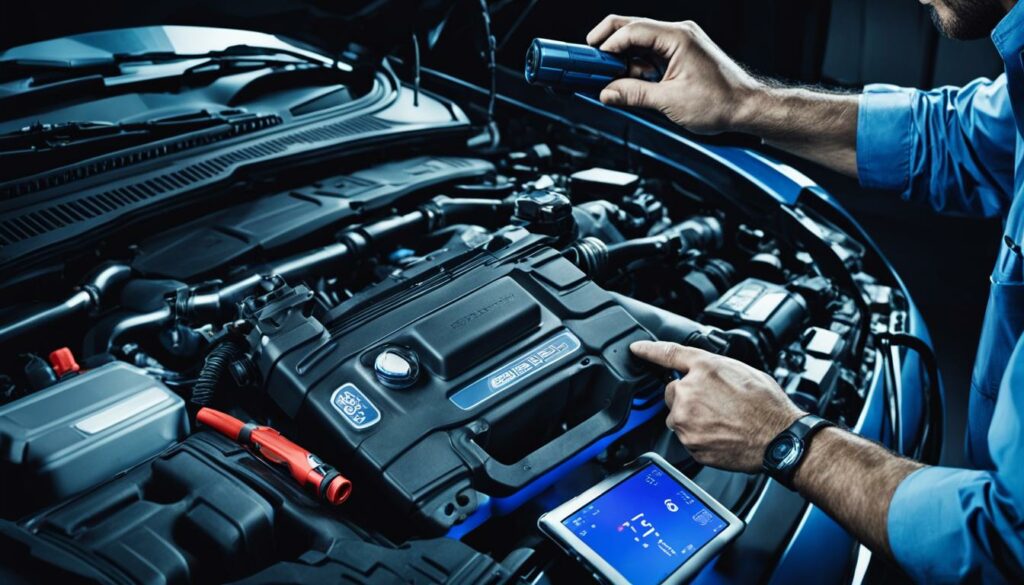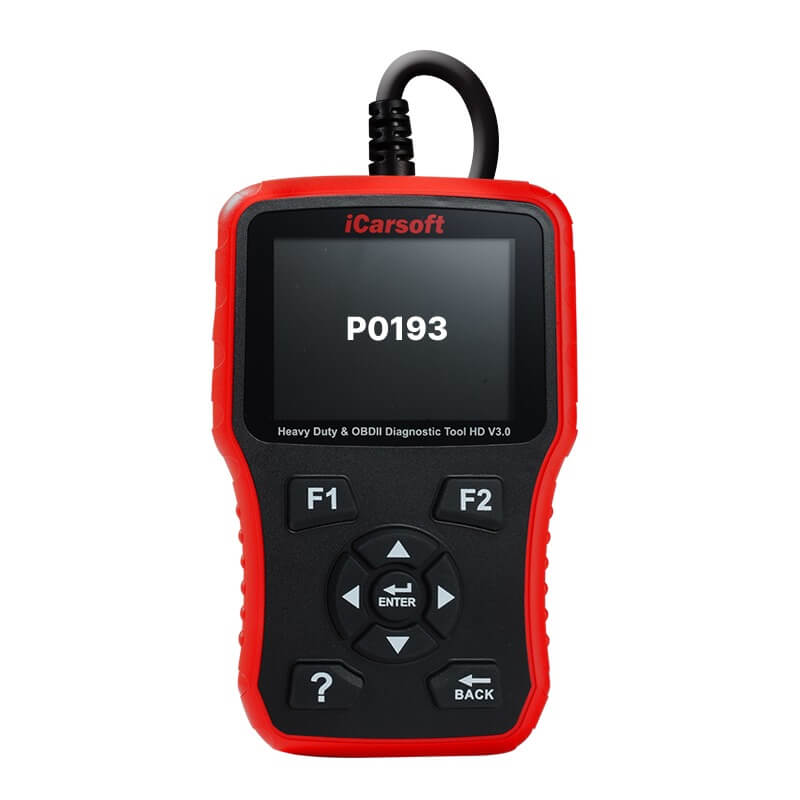P0193 – Fuel Rail Pressure Sensor Circuit High
POSTED IN pcodes
Welcome to our article about the P0193 error code: Fuel Rail Pressure Sensor Circuit High. If you’ve encountered this diagnostic trouble code (DTC), it’s important to understand its implications for your vehicle’s fuel system and engine performance.
The P0193 code specifically relates to a high voltage reading from the fuel rail pressure sensor, which is responsible for monitoring the fuel pressure and ensuring the engine receives the correct amount of fuel. When the values deviate too much from the required levels, the P0193 code is triggered, indicating a potential malfunction in the fuel rail pressure sensor or related components.
In this article, we will explore the symptoms, causes, and diagnostic process associated with the P0193 code. We will also discuss the importance of promptly addressing this issue to avoid further damage to your engine.
Key Takeaways:
- The P0193 code indicates a high voltage reading from the fuel rail pressure sensor in your vehicle.
- Symptoms of the P0193 code include difficulty accelerating, increased fuel consumption, and poor engine performance.
- Common causes of the P0193 code include a faulty fuel pump, corroded wiring, or a malfunctioning fuel rail pressure sensor.
- Diagnosing the P0193 code involves using an OBD-II reader, conducting visual inspections, and performing fuel system tests.
- Prompt repair of the P0193 code is crucial to prevent further engine damage and ensure optimal performance.
Understanding the P0193 Code
The P0193 code, also known as a diagnostic trouble code (DTC), indicates a high voltage reading from the fuel rail pressure sensor. This sensor plays a crucial role in measuring the fuel pressure in the fuel rail and transmitting that data to the engine control unit (ECU). When the voltage from the sensor exceeds the calibrated limit for a specific duration, the P0193 code is triggered. This code is typically caused by a malfunctioning fuel rail pressure sensor, faulty wiring connected to the sensor, or abnormal fuel pressure. If left unaddressed, the P0193 code can lead to reduced fuel economy, decreased engine power, failed emissions tests, and an illuminated check engine light.
To better understand the P0193 code, it’s essential to dive deeper into its possible causes and implications. Let’s explore the factors that contribute to this fault and how they can impact your vehicle’s performance.
Buy tested tuning file for Adblue / EGR / DPF / Adblue off now!
Common Symptoms of the P0193 Code
When your vehicle displays the P0193 code, it can manifest several noticeable symptoms. Being aware of these symptoms will help you identify and address the underlying issue. Here are the common symptoms associated with the P0193 code:
- Illuminated check engine light: The check engine light on your dashboard may turn on, indicating a potential issue with the fuel rail pressure sensor circuit.
- Reduced gas mileage: Your vehicle’s fuel efficiency may decrease, causing you to consume more fuel for the same distance traveled.
- Lack of power: You may experience a decrease in engine power, making acceleration and climbing hills more challenging.
- Engine hesitation or stalling: Your engine may hesitate or stall, especially when idling or coming to a stop.
- Unusual tailpipe emissions: You might notice unusual exhaust emissions, such as excessive smoke or a strong odor.
- Triggering of fuel trim codes: The P0193 code can trigger other fuel trim-related codes, such as P0172 for a rich fuel system.
- Failed emissions tests: Your vehicle may not pass emissions tests due to increased tailpipe emissions or fuel system malfunctions.
It is important to note that not all vehicles will exhibit the same symptoms, and in some cases, there may be no observable symptoms at all. However, if you experience any of these symptoms in conjunction with the P0193 code, it is strongly recommended to have your vehicle inspected by a qualified mechanic to identify and resolve the underlying issue.

Did you know?
The P0193 code can trigger a decrease in fuel efficiency, engine power, and emissions compliance, leading to various noticeable symptoms. Identifying and addressing these symptoms promptly can help prevent further damage to your vehicle and ensure optimal performance.
Diagnosing the P0193 Code
Diagnosing the P0193 code requires a systematic approach to determine the underlying cause. By following a diagnostic process, you can effectively identify and address the issue. The following steps outline the diagnostic process for the P0193 code:
- Retrieve trouble codes with an OBD-II reader: Using an OBD-II reader, connect to the vehicle’s onboard diagnostic system to retrieve the specific trouble codes, including the P0193 code.
- Perform a visual inspection: Conduct a thorough visual inspection to check for any visible damage or corrosion in critical components such as the wiring harness, fuel lines, and fuel rail pressure sensor. Look for any signs of wear, loose connections, or other issues that could impact the fuel system.
- Conduct a wiring harness test: Use a multimeter to perform a wiring harness test. This test helps identify any electrical faults or abnormalities in the wiring that could be causing the P0193 code. Check for continuity, shorts, or open circuits in the wiring harness.
- Perform a fuel pressure test: Use a fuel pressure gauge to measure the fuel pressure in the system. Compare the reading to the manufacturer’s specifications to determine if the fuel system is functioning properly. A low or inconsistent fuel pressure reading could be indicative of a problem contributing to the P0193 code.
- Conduct a fuel rail pressure sensor test: Test the fuel rail pressure sensor using a multimeter or specialized diagnostic tool. Measure the voltage readings of the sensor during various engine states, such as idle, acceleration, and deceleration. Compare these readings to the manufacturer’s specifications for proper sensor operation.
- Perform a comprehensive fuel system inspection: Inspect the entire fuel system, including the fuel pump, fuel filter, and fuel injectors, for any signs of damage, blockages, or malfunction. Pay close attention to any components that could contribute to high fuel pressure readings.
By following this diagnostic process, you can pinpoint the root cause of the P0193 code. These steps help to ensure an accurate diagnosis and guide the repair process effectively.

Note: The diagnostic process for the P0193 code may vary depending on the vehicle make, model, and year. It is always recommended to consult the vehicle’s service manual or seek professional assistance for a thorough diagnosis and repair.
Fixing the P0193 Code
Once the root cause of the P0193 code has been identified, you can take appropriate steps to fix the issue. Here are some recommended solutions:
- Fuel system cleaning: Perform a thorough fuel system cleaning to remove any debris or clogs that may be affecting fuel flow. This can help improve the overall performance of your fuel injection system.
- Fuel rail pressure sensor cleaning: Clean the fuel rail pressure sensor to ensure it provides accurate readings. Use a suitable cleaning solution and follow the manufacturer’s instructions for proper cleaning techniques.
- Fuel filter replacement: If necessary, replace the fuel filter to ensure a clean and unobstructed fuel flow. A clogged fuel filter can contribute to fuel pressure issues and trigger the P0193 code.
- Fuel pump replacement: In some cases, a faulty fuel pump can cause the P0193 code. If after inspection, you determine that the fuel pump is the culprit, it may need to be replaced to restore proper fuel system functionality.
- OBD-II code clearing: Once the repairs are complete, use an OBD-II diagnostic tool to clear the P0193 code and reset the check engine light. This ensures that the issue has been resolved and allows you to monitor for any new issues that may arise.
Remember to use quality replacement parts and follow proper installation procedures to ensure effective and long-lasting repairs. Taking these steps can help address the P0193 code and restore the optimal performance of your vehicle’s fuel system.
Importance of Prompt Repair for the P0193 Code
Prompt repair of the P0193 code is crucial to prevent further damage to your engine and fuel system. Ignoring this code can result in severe consequences, including engine damage, reduced engine performance, and decreased fuel efficiency. It is vital to address the underlying issue causing the code as soon as possible to avoid costly repairs and potential safety hazards.
If you continue to ignore the P0193 code, it can lead to significant engine damage. The fuel rail pressure sensor plays a vital role in the proper functioning of your fuel system. When this sensor fails to provide accurate readings, it can disrupt fuel flow and lead to engine misfires, inefficient combustion, and even complete engine failure. Timely repair is essential to mitigate the risk of expensive repairs or the need for a full engine replacement.
In addition to engine damage, ignoring the P0193 code can negatively impact your engine’s performance. An abnormal fuel pressure reading affects the fuel injection system’s operation, resulting in poor acceleration, rough idling, and decreased overall power. Your vehicle may not respond as quickly or smoothly as before, affecting your driving experience and potentially putting you at risk on the road.
Furthermore, a faulty fuel system can significantly decrease your fuel efficiency. A fuel rail pressure sensor malfunction causes fuel supply irregularities, leading to an incorrect mixture of fuel and air. This imbalance can result in excessive fuel consumption and reduced miles per gallon, significantly impacting your wallet and contributing to unnecessary emissions.
Given the potential consequences of neglecting the P0193 code, it is crucial to prioritize repair urgency. Seeking professional assistance is recommended to accurately diagnose and fix the underlying issue. Experienced technicians have the expertise and tools to identify the root cause of the code, ensuring an effective and long-lasting repair.
If professional assistance is temporarily unavailable, there are alternative solutions to consider. Some platforms offer the option to upload the Engine Control Unit (ECU) file to remove the P0193 code permanently. While this solution may provide temporary relief, it is essential to note that addressing the underlying problem is critical for long-term engine and fuel system health.
Conclusion
The P0193 code related to the fuel rail pressure sensor circuit high is a common issue that can significantly impact the performance and fuel efficiency of your engine. Understanding the symptoms, causes, and diagnostic process for this code is crucial for timely repairs.
To resolve the P0193 code effectively, it is essential to address the root cause of the issue. This could be a faulty fuel rail pressure sensor, wiring problems, or a malfunctioning fuel system component. Prompt repair is highly recommended to prevent further damage and ensure optimal engine operation.
If you are unable to access professional assistance, alternative solutions are available. For instance, you can consider uploading the Engine Control Unit (ECU) file to a specialized portal to permanently remove the P0193 code. This can provide a viable option for resolving the issue when immediate professional help is not accessible.
FAQ
What does the P0193 error code mean?
The P0193 error code refers to a problem with the fuel rail pressure sensor in the engine. This sensor monitors the amount of fuel and the fuel pressure to ensure the engine receives the correct amount of fuel. If the values deviate too much from the required amounts and exceed the limit, the P0193 error code is triggered.
What are the common causes of the P0193 error code?
Common causes for this issue include a faulty fuel pump, a vacuum leak, corroded wiring, a clogged fuel filter, a faulty fuel pressure regulator, or a faulty fuel rail pressure sensor.
What are the symptoms of the P0193 error code?
Symptoms of a P0193 error code include difficulty accelerating, trouble starting the car, increased fuel consumption, a strange emissions scent, poor engine performance, and an illuminated check engine light.
How is the P0193 code diagnosed?
Diagnosing the P0193 code involves using an OBD-II reader to retrieve the trouble codes, performing a visual inspection, conducting a wiring harness test, and performing a fuel pressure test and a fuel rail pressure sensor test.
What steps can be taken to fix the P0193 code?
Steps to fix the P0193 code may include fuel system cleaning, fuel rail pressure sensor cleaning, fuel filter replacement, fuel pump replacement, and clearing the OBD-II code.
Why is prompt repair of the P0193 code important?
Prompt repair of the P0193 code is crucial to prevent further damage to the engine and fuel system. Ignoring this code can lead to engine damage, reduced engine performance, and decreased fuel efficiency.


